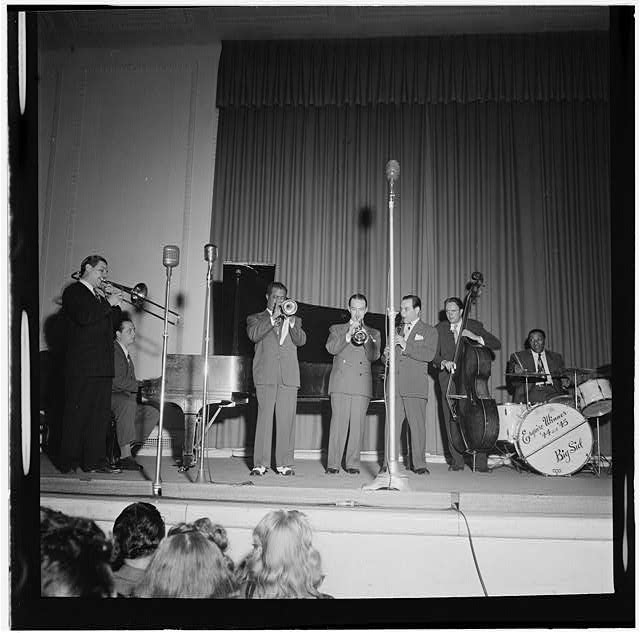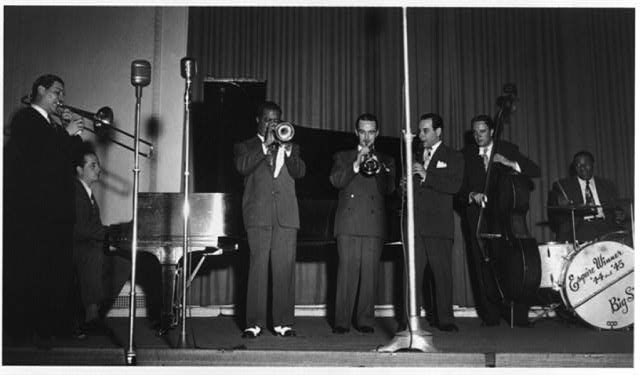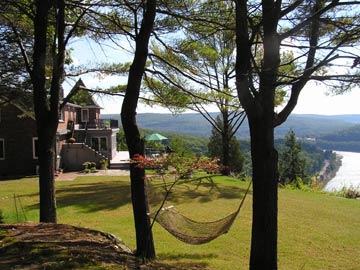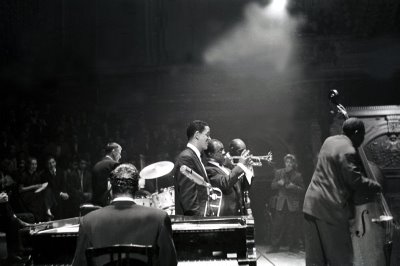“When statesmen forsake their own private conscience for the sake of their public duties, they lead their country by a short route to chaos.”
Robert Bolt, A Man for All Seasons
Archives for 2008
CAAF: Afternoon coffee
• James Hynes recommends ten spooky stories for midnight reading. (Via Maudie.)
• John Updike talks to Emily Nussbaum about The Widows of Eastwick, his follow-up to 1984’s Witches of Eastwick. (Via Sarah.)
• Vampire bats, leeches, chiggers and bed bugs are among the bloodsuckers featured in Dark Banquet, a new book by biologist Bill Schutt which, as it happens, I trotted to the bookstore last night to purchase. (Via Jenny.)
TT: A glimpse of history
 On May 17, 1947, Louis Armstrong gave an all-star concert at New York’s Town Hall that changed his life. He had been leading a touring big band since 1929, but World War II brought the Swing Era to an end, and by 1947 Armstrong knew that he had to find a different way to package himself for postwar audiences. He did so at the Town Hall concert, which teamed him with a small group whose members included Sid Catlett, Bobby Hackett, and Jack Teagarden. As I wrote in A Cluster of Sunlight: The Life of Louis Armstrong:
On May 17, 1947, Louis Armstrong gave an all-star concert at New York’s Town Hall that changed his life. He had been leading a touring big band since 1929, but World War II brought the Swing Era to an end, and by 1947 Armstrong knew that he had to find a different way to package himself for postwar audiences. He did so at the Town Hall concert, which teamed him with a small group whose members included Sid Catlett, Bobby Hackett, and Jack Teagarden. As I wrote in A Cluster of Sunlight: The Life of Louis Armstrong:
It was, for one thing, the first time that he had ever given a full-evening concert with a combo, and it appears to have been the first time since 1926 that he had appeared in public as the leader of a small group of his own. Not that he needed a good band to play well. “I work with two bands, the one on stage and the one in my head,” he would later tell Ruby Braff. “If they sound good on stage, O.K., I’ll play with them. If not, I just turn up the volume of the band in my head.” But the band with which he was playing at Town Hall that night sounded very good indeed…
At the time, comparatively little fuss was made over the event, which went unmentioned in the New York Times, Time, and The New Yorker. Only the jazz press took note of the occasion: Down Beat‘s review was headed “Satchmo’s Genius Still Lives,” while The Melody Maker ran a piece by a correspondent who reported that Armstrong’s playing “had all the freshness and vigour of the early Hot Five and Seven days. He never strove for effects, never played to the gallery.” But one person in the audience was listening with the closest possible attention. Joe Glaser, Armstrong’s manager, who was sitting in a box seat, knew at once that his troubles were over. Not only had Armstrong proved himself capable of thrilling a crowd without the support of a big band, but in Jack Teagarden he had found the foil of a lifetime. Like the businessman he was, Glaser struck while the iron was smoking hot. He signed Teagarden to a long-term contract on Monday morning, then gave the members of the big band two months’ notice.
Three months after that, Armstrong opened at Billy Berg’s, a Los Angeles nightclub, leading a six-piece combo whose other members included Sid Catlett and Jack Teagarden. The engagement was a huge success, and for the rest of his life Armstrong toured the world with the band that Glaser later dubbed “the All Stars.”
 Rarely have microphones been present at so historically significant a one-night stand as Armstrong’s 1947 Town Hall concert, but Ernie Anderson, the promoter who persuaded Glaser to let him present the concert, took care to record it, and the resulting album leaves no possible doubt that it was as good as everybody remembered. Fortunately, the great jazz photographer Bill Gottlieb was also present, and took a beautiful group shot of Armstrong and his musicians in full cry. A cropped version of the photo was published two months later in Down Beat, but the original vanished into Gottlieb’s files, and it didn’t resurface until he left his personal archive of sixteen hundred prints and negatives to the Library of Congress, which has created an online collection of Gottlieb’s work.
Rarely have microphones been present at so historically significant a one-night stand as Armstrong’s 1947 Town Hall concert, but Ernie Anderson, the promoter who persuaded Glaser to let him present the concert, took care to record it, and the resulting album leaves no possible doubt that it was as good as everybody remembered. Fortunately, the great jazz photographer Bill Gottlieb was also present, and took a beautiful group shot of Armstrong and his musicians in full cry. A cropped version of the photo was published two months later in Down Beat, but the original vanished into Gottlieb’s files, and it didn’t resurface until he left his personal archive of sixteen hundred prints and negatives to the Library of Congress, which has created an online collection of Gottlieb’s work.
I was lucky enough to be casually acquainted with Gottlieb, who died a couple of years ago, and I knew as soon as I started choosing the illustrations for A Cluster of Sunlight that his Town Hall photograph would have to be included. I’m pleased to say that his son Edward has given me permission to reprint this essential document of the most consequential performance of Louis Armstrong’s life. It isn’t as well known as it ought to be, perhaps because it isn’t all that dramatic, but even so, no Armstrong biography could possibly be complete without it.
TT: Snapshot
The George Shearing Quintet plays “Conception”:
(This is the latest in a weekly series of arts-related videos that appear in this space each Wednesday.)
TT: Don’t call us, we’ll call you (maybe)
 Mrs. T and I are departing this afternoon for a brief, well-deserved holiday at Ecce Bed and Breakfast, the Catskills inn where we honeymooned a year ago. Our deflector shields will be set to maximum until Sunday, when we return to New York with what I expect to be the utmost reluctance. You’ll find the usual almanac entries and theater-related postings in this space, but if you need anything other than that between now and then, ask somebody else.
Mrs. T and I are departing this afternoon for a brief, well-deserved holiday at Ecce Bed and Breakfast, the Catskills inn where we honeymooned a year ago. Our deflector shields will be set to maximum until Sunday, when we return to New York with what I expect to be the utmost reluctance. You’ll find the usual almanac entries and theater-related postings in this space, but if you need anything other than that between now and then, ask somebody else.
Later.
TT: Almanac
“Unlike any other visual image, a photograph is not a rendering, an imitation or an interpretation of its subject, but actually a trace of it. No painting or drawing, however naturalist, belongs to its subject in the way that a photograph does.”
John Berger, About Looking
TT: Adventures in copyright
 One of the minor pleasures of writing a biography is picking the photographs that will be used to illustrate it–so long as you can get permission to reproduce them. When you can’t, it’s pure hell.
One of the minor pleasures of writing a biography is picking the photographs that will be used to illustrate it–so long as you can get permission to reproduce them. When you can’t, it’s pure hell.
In addition to looking through some two thousand photos of Louis Armstrong at the Armstrong Archives, I spent several days trolling the Web for images, mostly in vain, since just about everything I found was over-familiar and/or unusable. I did, however, run across one spectacular shot of Armstrong and the All Stars on stage in Amsterdam in 1955, and no sooner did I find it on a Web-based photo album than I knew I wanted to include it in A Cluster of Sunlight: The Life of Louis Armstrong. I’ve seen hundreds of pictures of Armstrong in performance, but I can’t think of one that does a better job of suggesting the atmosphere of a jazz concert.
On top of that, this particular photo is of what I believe to have been Armstrong’s best working group, the one that featured Edmond Hall on clarinet, Trummy Young on trombone, and Billy Kyle on piano. Armstrong, as it happens, felt exactly the same way. As he said in a little-known 1956 interview quoted in A Cluster of Sunlight:
Oh yeah, that first group of All Stars [i.e., the one that included Barney Bigard on clarinet, Sid Catlett on drums, Earl Hines on piano, and Jack Teagarden on trombone] was a good one all right, but I think the group I have now is the best of ’em all. It seems to me this band gets more appreciation now than the other All Stars. Some of the other Stars got so they was prima donnas and didn’t want to play with the other fellows. They wouldn’t play as a team but was like a basket ball side with everybody trying to make the basket. They was great musicians, but after a while they played as if their heart ain’t in what they was doin’. A fella would take a solo but no-one would play him no attention–just gaze here, look around there. And the audience would see things like that–I don’t praise that kind of work y’ know….
The All Stars now ain’t like that and the audience appreciate the spirit in the band. As musicians they ain’t any better, but a lot of people say these boys seem like they’re real glad to be up there swingin’ with me.
Here is that same band playing “Muskrat Ramble” on TV in 1958:
Clearly, then, I had to include that image in my book. There was only one catch, but it was a huge one: the Web album didn’t include the photographer’s name or e-mail address. So what did I do? Simple: I told Ariel Davis, my trusty research assistant, to track the man down. It took her a couple of weeks to oblige, but she finally brought home the bacon.
Much to my surprise, it turned out that Joel Elkins, who shot what Ariel and I had taken by then to calling the Mystery Photo, knew who I was. “It’s a pleasure to be associated with a book about the great Louis Armstrong written by someone such as yourself,” he wrote. Elkins charged a token fee for permission to reprint his wonderful picture in A Cluster of Sunlight, asking only that we send him a signed copy of the book when it comes out next year. I can’t wait to oblige.
No, it’s not always that easy….
TT: Almanac
“We also have to learn to forget music. Otherwise we become addicted to the past.”
Keith Jarrett (quoted in The Wall Street Journal, Oct. 11, 2008)
